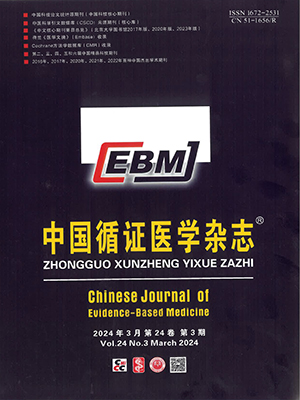| 1. |
Campecu L. Percutaneous radial artery approach for coronary angioplasty. Cathet Cardiovasc Diagn, 1989, 16(1):3-7.
|
| 2. |
Kiemeneij F, Laarman G. Percutaneous transradial artery approach for coronary stent implantation. Cathet Cardiovasc Diagn, 1993, 30(2):173-178.
|
| 3. |
陈灏珠, 林果为, 王吉耀, 等.实用内科学.第14版.北京:人民卫生出版社, 2013:1483-1494.
|
| 4. |
O'Gara PT, Kushner FG, Ascheim DD, et al. 2013 ACCF/AHA guideline for the management of ST-elevation myocardial infarction:a report of the American College of Cardiology Foundation/American Heart Association Task Force on Practice Guidelines. J Am Coll Cardiol, 2013, 61(4):e78-140.
|
| 5. |
Higgins JPT, Green S. Cochrane Handbook for Systematic Reviews of Interventions Version 5.1.0. The Cochrane Collaboration, 2011. Available at:www.cochrane-handbook.org.
|
| 6. |
Review Manager (RevMan)[Computer program]. Version 5.2. Copenhagen:The Nordic Cochrane Centre, The Cochrane Collaboration, 2012.
|
| 7. |
Saito S, Tanaka S, Hiroe Y, et al. Comparative study on transradial approach vs. trans-femoral approach in primary stent implantation for patients with acute myocardial infarction:results of the Test for Myocardial Infarction by Prospective Unicenter Randomization for Access Sites (TEMPURA) trial. Catheter Cardiovasc Interv, 2003, 59(1):26-33.
|
| 8. |
Cantor WJ, Puley G, Natarajan MK, et al. Radial versus femoral access for emergent precutaneous coronary intervention with adjunct glycoprotein Ⅱb/Ⅲa inhibition in acute myocardial infarction-the RADIAL-AMI pilot randomized trial. Am Heart J, 2005, 150(3):543-549.
|
| 9. |
Brasselet C, Tassan S, Nazeyrollas P, et al. Randomized comparison of femoral versus radial approach for percutaneous coronary intervention using abciximab in acute myocardial infarction:results of the FARMI trial. Heart, 2007, 93(12):1556-1561.
|
| 10. |
Li WM, Li Y, Zhao JY, et al. Safety and feasibility of emergent percutaneous coronary intervention with the transradial access in patients with acute myocardial infarction. Chin Med J (Engl), 2007, 120(7):598-600.
|
| 11. |
Yan ZX, Zhou YJ, Zhao YX, et al. Safety and feasibility of transradial approach for primary percutaneous coronary intervention in elderly patients with acute myocardial infarction. Chin Med J (Engl), 2008, 121(9):782-786.
|
| 12. |
Chodor P, Krupa H, Kurek T, et al. Radial Versus Femoral Approach for Percutaneous Coronary Interventions in Patients With Acute Myocardial Infarction (RADIAMI):a prospective, randomized, single center clinical trial. Cardiol J, 2009, 16(4):332-340.
|
| 13. |
Gan L, Lib Q, Liuc R, et al. Effectiveness and feasibility of transradial approaches for primary percutaneous coronary intervention in patients with acute myocardial infarction. J Nanjing Med Univ, 2009, 23(4):270-274.
|
| 14. |
Hou L, Wei YD, Li WM, et al. Comparative study on transradial versus transfemoral approach for primary percutaneous coronary intervention in Chinese patients with acute myocardial infarction. Saudi Med J, 2010, 31(2):158-162.
|
| 15. |
Chodór P, Kurek T, Kowalczuk A, et al. Radial vs. femoral approach with StarClose clip placement for primary percutaneous coronary intervention in patients with ST-elevation myocardial infarction. RADIAMI Ⅱ:a prospective, randomized, single centre trial. Kardiol Pol, 2011, 69(8):763-771.
|
| 16. |
Romagnoli E, Biondi-Zoccai G, Sciahbasi A, et al. Radial versus femoral randomized investigation in ST-segment elevation acute coronary syndrome:the RIFLE-STEACS (Radial Versus Femoral Randomized Investigation in ST-Elevation Acute Coronary Syndrome) study. J Am Coll Cardiol, 2012, 60(24):2481-2489.
|
| 17. |
Mehta SR, Jolly SS, Cairns J, et al. Effects of radial versus femoral artery access in patients with acute coronary syndromes with or without ST-segment elevation. J Am Coll Cardiol, 2012, 60(24):2490-2499.
|
| 18. |
Michael TT, Alomar M, Papayannis A, et al. A randomized comparison of the transradial and transfemoral approaches for coronary artery bypass graft angiography and intervention. JACC Cardiovasc Interv, 2013, 6(11):1138-1144.
|
| 19. |
Bernat I, Horak D, Stasek J, et al. ST-segment elevation myocardial infarction treated by radial or femoral approach in a multicenter randomized clinical trial:the STEMI-RADIAL trial. J Am Coll Cardiol, 2014, 63(10):964-972.
|
| 20. |
Kołtowski L, Filipiak KJ, Kochman J, et al. Access for percutaneous coronary intervention in STEMI:radial vs. femoral-prospective, randomized clinical trial-OCEAN RACE trial. Kardiol Pol, 2014, 72(7):604-611.
|
| 21. |
庞军, 李娜, 白明, 等.桡动脉径路PCI对比股动脉径路PCI对冠心病人疗效和安全性分析.中国循环杂志, 2013, 8(28):88.
|
| 22. |
白启才, 崔丽萍, 李珍珍.经桡动脉和股动脉途径行冠状动脉介入治疗的对比分析.中华老年心脑血管病杂志. 2010, 12(5):426-427.
|
| 23. |
Mamas MA, Ratib K, Routledge, et al. Influence of access site selection on PCI-related adverse events in patients with STEMI:meta-analysisof randomised controlled trials. Heart, 2012, 98(4):303-311.
|
| 24. |
Dominique Joyal, Olivier F, Bertrand, et al. Meta-Analysis of Ten Trials on the Effectiveness of the Radial Versus theFemoral Approach in Primary Percutaneous Coronary Intervention. Am J Cardiol, 2012, 109(6):813-818.
|
| 25. |
Yokoyama N, Takeshita S, Ochiai M, et al. Anatomic Variations of the radial artery in patients undergoing trans radial coronary intervention. Cahet Cardiovasc Interv, 2000, 49(4):357-362.
|
| 26. |
Kiemeneij F, Lasman GJ, Odekerken D, et al. A randomized comparison of percutaneous transluminal coronary angioplasty by the radial, brachial and femoral approaches:the access study. J Am Coll Cardiol, 1997, 29(6):1269.
|
| 27. |
Pawlowski T, Kulawik T, Gil RJ. Transradial approach to' ell interventional procedures a matter of the learning curve. JACC Cardiovasc Interv, 2010, 3(4):463.
|
| 28. |
Karrowni W, Vyas A, Giacomino B, et al. Radial versus femoral access for primary percutaneous interventions in ST-segment elevation myocardial infarction patients:a meta-analysis of randomized controlled trials. JACC Cardiovasc Interv, 2013, 6(8):814-823.
|
| 29. |
Mamas A Mamas, Karim Ratib, et al. Influence of access site selection on PCI-related adverse events in patients with STEMI:meta-analysis of randomized controlled trials. Heart, 2012, 98(4):303-311.
|
| 30. |
Sciahbasi A, Romagnoli E, Trani C, et al. Evaluation of the "learning curve" for left and right radial approach during percutaneous coronary procedures. Am J Cardiol, 2011, 108(2):185-188.
|




